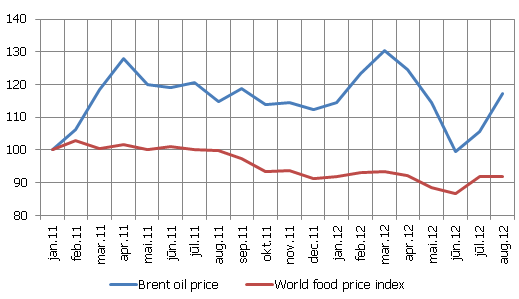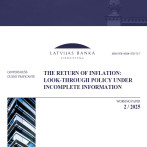Annual inflation remains under 2%
With consumer prices down by 0.3% month-on-month, the annual inflation in August remained low (at the July level of 1.7%). The 12-month average inflation dropped to 3.1%.
Even though a rise in the prices of some consumer food (mostly animal products) prices, the seasonal effect on the drop of food prices equalled the one of August a year ago. The rise in global food prices has abated for now. With the first estimates regarding the new harvest in July, the world grain prices rose rapidly. The prices of sugar also went up. As the harvest estimates got clearer in August, both the prices of grain and overall food prices stabilized. Sugar prices even dropped. The stabilizing of grain prices were positively impacted also by Russia abstaining from limiting exports. Such trends could lessen the pressure on the prices of grain products in the domestic market. The abating of grain price rises is important also for the related branches, e.g., meat production, since grain is used as cattle feed.
The global oil prices gradually stabilized in August at a higher level than the July average and slightly higher year-on-year. The contribution from fuel prices in both the monthly and annual inflation was thus positive (0.3 and 0.4 percentage points respectively).
Figure 1. World oil and food price indexes, January 2011 = 100%.

Sources: Reuters and FAO
The contribution of the so-called base effects to the August annual inflation was not as substantial as in previous months. The reason is that compared to July the development trends of the most important inflation contributing factors in August were similar to those in the same time period last year. For example, the indirect tax rates in August did no change month-on-month, nor where they changed last August. Rapid changes in administered prices were likewise not observed either in August of this year or a year ago.
On the demand side – the salary and productivity trends point to unit of labour costs not creating a pressure on the consumer price level. Compared to the second quarter of 2011, in the same quarter of this year they have dropped both nominally and in real terms. Quarter-on-quarter the unit of labour costs have remained unchanged in nominal and dropped in real terms. As the demand side did not motivate a rise in prices, core inflation turned negative in August, bringing the overall annual inflation by 0.1 pp. A substantial drop was primarily observed in the prices of wearing apparel and footwear (by 4.1% compared to August of 2011), household equipment and transport vehicles as well as several rest- and culture-related goods and communication services.
In September, the seasonal impact will shift from food items to a different segment, i.e. primarily wearing apparel and footwear where a rise in the prices of the new season items will be observed (in part it is already the case in August, yet in August sales of summer items are still going on). Exceeding the seasonal impact of previous years is not expected however. The annual inflation could remain under 2% for a short period of time. As the heating season begins, it could stabilize a little above 2%, since last year there was a drop in thermal energy prices in the first months of the heating season which is not expected this year because of higher prices of oil products.
Textual error
«… …»






